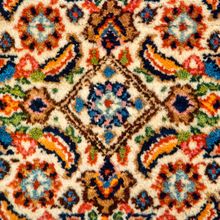Birjand Rug
Revision as of 08:20, 4 March 2020 by Niloufar Alipour (talk | contribs)
| Birjand Rug | |
|---|---|
 Design of Birjand Rug (Rugman) | |
| General information | |
| Name | Birjand Rug |
| Original name | قالی بیرجند |
| Alternative name(s) | Birjand Carpet |
| Origin | |
| Category | City |
| Technical information | |
| Common designs | Medallion |
| Common colors | Red, Crimson, Cream, Navy Blue, Beige |
| Dyeing method | Natural, Synthetic |
| Pile material | Wool |
| Foundation material | Cotton |
| Knot type | Asymmetrical (Persian), Jufti |
Birjand rugs originate from Birjand. Located in the southern part of the Province of Khorasan, it has a history dating back more than 2000 years. Its population of nearly 120,000 people own approximately 18,000 carpet looms weaving magnificent area rugs reputed to be the finest produced in eastern Iran. The knot style used on Birjand rugs is the Persian asymmetrical knot, due in large part to the fact that area rugs woven with this knot tend to be more accurate and symmetrical. Birjand's rugs are famous and known internationally as "Mood Carpet". Mood is the name of a region in Birjand and the rug weaving style is unique to that region.
History
Materials
Foundation and Pile
Techniques and structures
Color and dyeing
Motifs and Designs
Weaving techniques
See also
References
Bibliography
- Abraham Levi Moheban, (2015), The Encyclopedia of Antique Carpets: Twenty-Five Centuries of Weaving, NewYork: Princeton Architectural Press.